Monthly economic brief: December 2020
The monthly economic brief provides a summary of latest key economic statistics, forecasts and analysis on the Scottish economy.
This document is part of a collection
Business Activity
Following a period of stabilisation in the third quarter, business activity has weakened into the fourth quarter, particularly in consumer facing parts of the services sector.
Proportion of business trading[2]
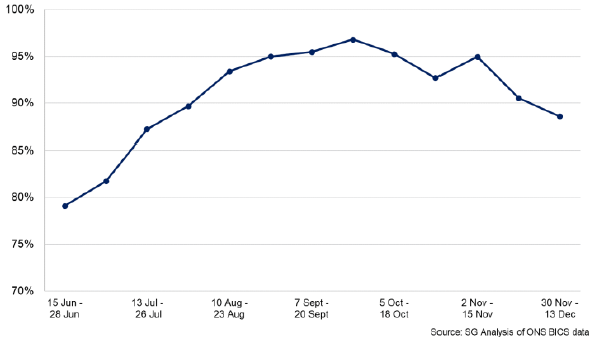
(businesses with 10+ employees and a presence in Scotland)
- The easing of national lockdown restrictions during the second and third quarters of the year enabled many businesses to gradually reopen, and by the start of October, the proportion of business reporting as currently trading had risen to 97%, up from 79% in June.
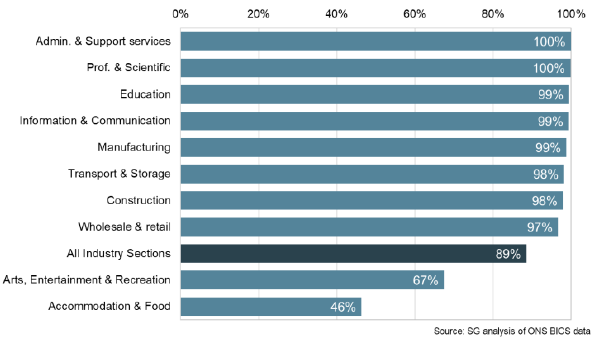
(businesses with 10+ employees and a presence in Scotland)
- However, this proportion has fallen back over October and November as regional restrictions have been introduced and latest data into the first half of December showed that the proportion of businesses currently trading had fallen to 89%, its lowest rate since the second half of July.
- The Accommodation and Food Services sector (46%) and the Arts, Entertainment & Recreation sector (67%) continue to have the lowest proportions of businesses trading in December and have both decreased sharply from November.
Business output
- The RBS Purchasing Managers Index (PMI)[3] business survey reported that business activity in Scotland stabilised following its low point in April during national lockdown and returned to growth in the third quarter of the year across both the manufacturing and service sectors.
- However with the pace of growth slowing in September, business activity contracted across October and, to a lesser extent, November (47.3, up from 43.2) reflecting falls in new orders.
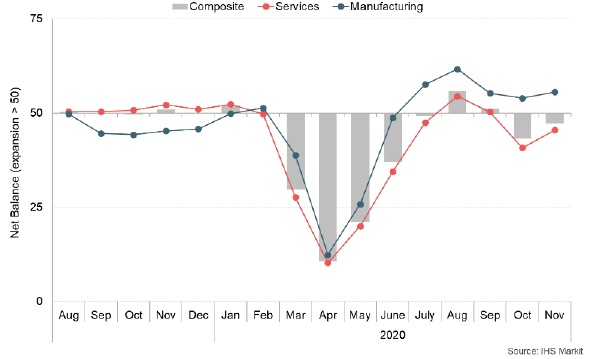
- At a sector level, there has been some divergence of activity in the fourth quarter. Manufacturing activity has continued to grow relatively robustly in November (55.6) while Service sector activity contracted (45.5) though less sharply than in October.
- The fall in business activity in November was linked to the latest restrictions introduced in October and November. However, looking to the year ahead, business expectations remained positive and confidence rose to a 3-month high.
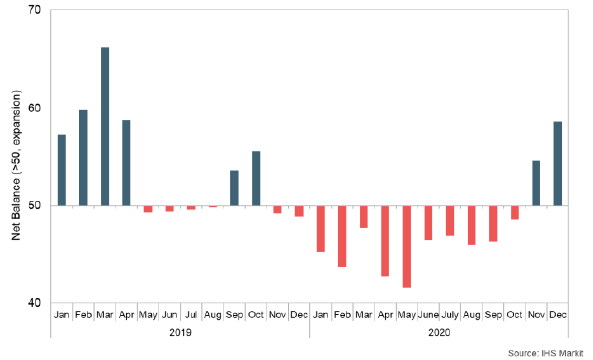
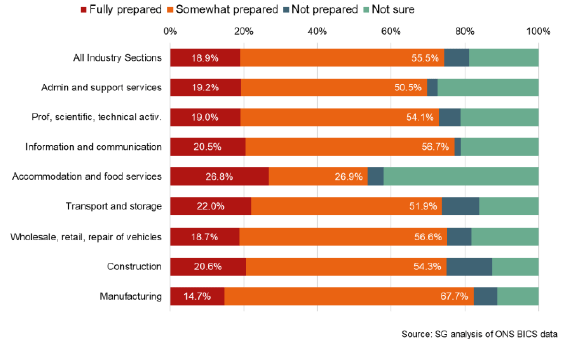
(Share of relevant businesses trading, with 10+ employees and a presence in Scotland)
- The more recent UK Flash PMI for December[4] signalled a return to business output growth following a fall in November. While Service sector activity remained largely unchanged over the month, growth was supported by a pickup in Manufacturing new orders and as firms brought forward some purchases ahead of the end of the EU transition phase.
- This suggests that some firms are preparing for the end of the EU transition phase. In Scotland, latest BIC survey evidence suggests that, of businesses where preparedness for the end of the EU transition period is relevant, almost 19% were fully prepared for the end of the period, while a further 55% were somewhat prepared. However 7% were not prepared at all.
Monitoring the impact of restrictions
Following the end of the national lockdown earlier in the summer, there has been a reintroduction of local restrictions across the UK as areas have seen resurgences in Covid-19 cases. This has led to greater regional variation across the four nations in the level of restrictions that have been applied. The Scottish Government’s approach is to suppress the virus to a very low level while seeking to minimise the broader health, social and economic harms. The regional levels-based approach in Scotland has offered the opportunity to ensure that measures are applied in proportion to the threat posed by levels of infection in each area.
One indicator that can be used to help monitor the impact of restrictions is to look at mobility.[5] The adjacent chart shows how visits to retail and recreation hubs have been affected by restrictions.[6] For example, it is clear to see the impact of national restrictions such as the beginning and end of Wales’ “firebreaker” or the national lockdown in England. It is also possible to see an impact on the Scottish data following the introduction of Level 4 restrictions over 11 Local Authorities on 20 November although the data suggests that the overall impact in Scotland was less severe than the national lockdowns seen in Wales and England.
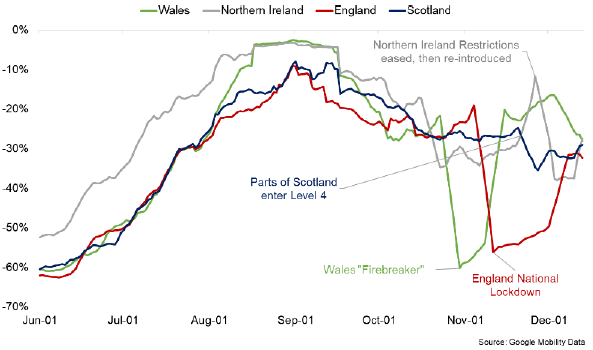
(% change from baseline 3 Jan - 7 Feb 2020)
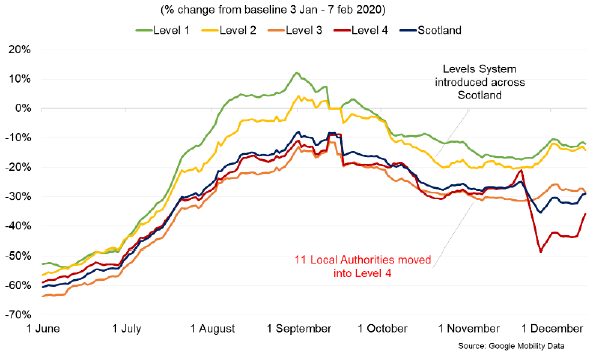
(% change from baseline 3 Jan - 7 Feb 2020)
Within Scotland, there has also been significant variation in visits to retail and recreation in different local authorities conditional on the level they were placed in. The adjacent chart compares the visits to retail and recreation by local authority (with local authorities allocated to their respective level as of 20 November). This shows that since the regional levels-based approach was first introduced on 2 November, visits to retail and entertainment hubs have declined across all levels to a degree. The greatest divergence occurred with the introduction of Level 4 restrictions on 20 November on 11 Local Authorities covering around 40% of the population and which entailed the closure of non-essential retail and hospitality. Consequently, the mobility data is a useful data source to monitor the impact on economic activity of the virus and the measures necessary to suppress it.
Trade
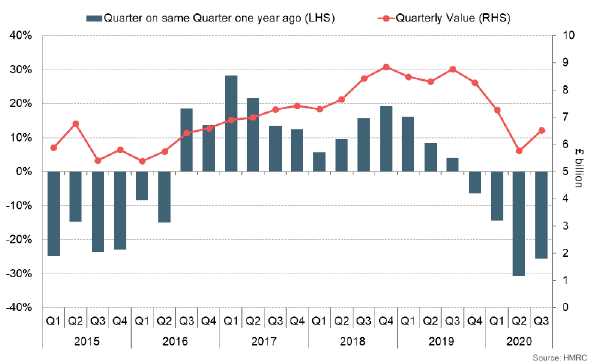
- On the back of significant global trade headwinds in 2019, many businesses have faced further challenges to trade in 2020 due to the pandemic and restrictions impacting demand and supply chains across countries.
- In Q3 2020, the value of Scotland’s international goods exports was £6.5 billion, down 26% compared to Q3 2019. The fall in exports over the year was driven partly by a fall in oil & gas exports (-60%) and a fall in beverages exports (-16%).[7]
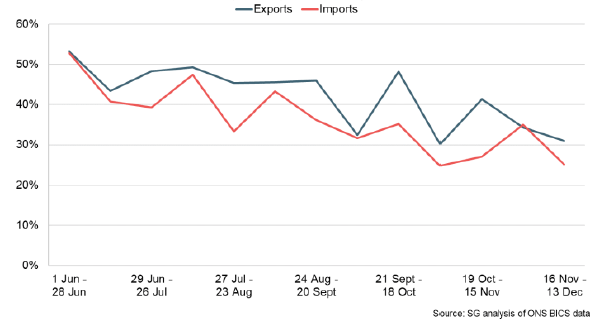
(Businesses with 10+ employees and a presence in Scotland, that are currently trading and have exported/imported over the past 12 months)
- BICS weighted Scotland estimates[8] suggests that the pandemic is continuing to have a significant impact on businesses trade into the start of December, though the data suggests that the impact has been gradually softening.
- At the start of December, 57% of respondents reported that their exports had not been affected (62% for imports), however 31% were exporting less than normal or had been unable to (25.1% for imports).
Contact
Email: OCEABusiness@gov.scot
There is a problem
Thanks for your feedback